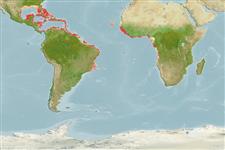Actinopterygii (ray-finned fishes) >
Perciformes (Perch-likes) >
Pomacentridae (Damselfishes) > Pomacentrinae
Etymology: Chromis: Greek, chromis = a fish, perhaps a perch (Ref. 45335).
Environment / Climate / Range
Ecology
Marine; reef-associated; non-migratory; depth range 0 - 60 m (Ref. 58047). Subtropical, preferred ?; 30°N - 23°S
Western Atlantic: Florida and Texas (USA) and throughout the Caribbean Sea to Brazil (Ref. 9626, 35834). Eastern Atlantic: St. Helena and Ascension islands and from São Tomé.
Size / Weight / Age
Maturity: Lm ? range ? - ? cm
Max length : 20.0 cm TL male/unsexed; (Ref. 3139); common length : 12.0 cm TL male/unsexed; (Ref. 3139)
Dorsal
spines
(total): 12;
Dorsal
soft rays
(total): 12-13;
Anal
spines: 2;
Anal
soft rays: 11 - 13. A prominent black spot at the pectoral-fin base, and a white spot just behind the posterior base of the soft dorsal fin (Ref. 7247). Grayish brown on back, shading to silvery gray on sides; dorsal fin broadly edged with bright yellow; upper and lower edges of caudal fin narrowly yellow with a submarginal dark band (Ref. 13442).
Adults generally occur in steep slopes and patch reefs. Diurnal species (Ref. 9626), they most commonly form moderate-sized feeding-schools over reef tops, rising above the bottom to feed on plankton, mainly copepods. Often seen with Chromis cyanea (Ref. 9710). Oviparous, distinct pairing during breeding (Ref. 205). Eggs are demersal and adhere to the substrate (Ref. 205). Males guard and aerate the eggs (Ref. 205). Rarely marketed (Ref. 3139).
Life cycle and mating behavior
Maturity | Reproduction | Spawning | Eggs | Fecundity | Larvae
Oviparous, distinct pairing during breeding (Ref. 205). Eggs are demersal and adhere to the substrate (Ref. 205). Males guard and aerate the eggs (Ref. 205).
Allen, G.R., 1991. Damselfishes of the world. Mergus Publishers, Melle, Germany. 271 p. (Ref. 7247)
IUCN Red List Status (Ref. 115185)
CITES (Ref. 94142)
Not Evaluated
Threat to humans
Harmless
Human uses
Fisheries: subsistence fisheries; aquarium: commercial
More information
ReferencesAquacultureAquaculture profileStrainsGeneticsAllele frequenciesHeritabilityDiseasesProcessingMass conversion
Tools
Special reports
Download XML
Internet sources
Estimates of some properties based on models
Phylogenetic diversity index (Ref.
82805): PD
50 = 0.5000 [Uniqueness, from 0.5 = low to 2.0 = high].
Bayesian length-weight: a=0.01514 (0.00681 - 0.03364), b=2.99 (2.80 - 3.18), in cm Total Length, based on LWR estimates for this (Sub)family-body shape (Ref.
93245).
Trophic Level (Ref.
69278): 3.0 ±0.0 se; Based on diet studies.
Resilience (Ref.
69278): Medium, minimum population doubling time 1.4 - 4.4 years (Preliminary K or Fecundity.).
Vulnerability (Ref.
59153): Low to moderate vulnerability (30 of 100) .
